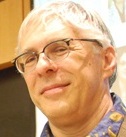7.10: Further replication complexities
- Page ID
- 4565
There are important differences between DNA replication in prokaryotes and eukaryotes. The DNA molecules found in eukaryotic nuclei are linear molecules, with free ends, known as telomeres This leads to problems replicating the ends of the DNA molecules, a problem solved by the enzyme complex telomerase (discussed briefly below)210. In contrast the DNA molecules found in bacteria and archaea are circular; there are no free ends211. This creates a topological complexity. After replication, the two double-stranded DNA circles are linked together. Long linear DNA molecules can also become knotted together within the cell. In addition, the replication of DNA unwinds the DNA, and this unwinding leads to what is known as the supercoiling of the DNA molecule. Left unresolved, supercoiling and knotting would inhibit DNA synthesis and the separation of replicated strands (perhaps you can explain why)212. These topological issues are resolved by enzymes known as topoisomerases. There are two types of topoisomerases. Type I topoisomerases bind to the DNA, catalyze the breaking of a single bond in one sugar-phosphate-sugar backbone, and allow the release of overwinding through rotation around the bonds in the intact chain. When the tension is released, and the molecule has returned to its “relaxed” form, the enzymecatalyzes the reformation of the broken bond. Both bond breaking and reformation are coupled to ATP hydrolysis. Type II topoisomerases are involved in “unknotting” DNA molecules. These enzymes bind to the DNA, catalyze the hydrolysis of both backbone chains, but hold on to the now free ends. This allows another strand to “pass through” the broken strand. The enzyme also catalyzes the reverse reaction, reforming the bonds originally broken.
Eukaryotic cells can contain more than 1000 times the DNA found in a typical bacterial cell. Instead of circles, they contain multiple linear molecules that form the structural basis of their chromosomes. Their linearity creates problems when it comes to replicating chromosome ends. This is solved by a catalytic system composed of proteins and RNA known as telomerase213. The eukaryotic DNA replication enzyme complex is slower (about 1/20th as fast) as prokaryotic systems. While a bacterial cell can replicate its circular ~3 x 106 base pair chromosome in ~1500 seconds using a single origin of replication, the replication of the billions of base pairs of eukaryotic DNAs involves the use of multiple (many) origins of replication, scattered along the length of each chromosome.
So what happens when replication forks collide with one another? In the case of a circular DNA molecule, with its single origin of replication, the replication forks resolve in a specific region known as the terminator. At this point type II topoisomerase allows the two circular DNA molecules to disengage from one another and move to opposite ends of the cell. The cell division machinery forms between the two DNA molecules. The system in eukaryotes, with their multiple linear chromosomes, is much more complexand involves a more complex molecular machines thatwe will return to, although only superficially, later.
Questions to answer & to ponder:
- During DNA/RNA synthesis what is the average ratio of productive to unproductive interactions between nucleotides and the polymerase?
- Where would genetic variation come from if DNA were totally stable and DNA replication was error-free?
- Draw a diagram to explain how the DNA polymerase might recognize a mismatched base pair.
- Why do you need to denature (melt) the DNA double-helix to copy it?
- How would DNA replication change if H-bonds were as strong as covalent bonds?
- How does the DNA polymerase complex know where to start replicating DNA?
- Make a cartoon of a prokaryotic chromosome, indicate where replication starts and stops. Now make a cartoon of eukaryotic chromosomes.
- List all of the unrealistic components in the DNA replication video: http://bcove.me/x3ukmq4x
- Why is only a single RNA primer needed to synthesize the leading strands, but multiple primers are needed to synthesize the lagging strands?
- During the replication of a single circular DNA molecule, how many leading and lagging strands are there? What is the situation in a linear DNA molecule?
- Assume that there is a mutation that alters the proof-reading function of the DNA polymerase complex - what will happen to the cell and the organism?
- Explain how the absence of the clamp would influence DNA replication?
References
- more on telomerase: blogs.scientificamerican.com/...as-too-little/
- The mitochondria and chloroplasts of eukaryotic cells also contain circular DNA molecules, another homology with their ancestral bacterial parents. ,
- see this video on DNA supercoiling and topoisomerases: http://youtu.be/EYGrElVyHnU
- http://en.Wikipedia.org/wiki/Telomerase
Contributors and Attributions
Michael W. Klymkowsky (University of Colorado Boulder) and Melanie M. Cooper (Michigan State University) with significant contributions by Emina Begovic & some editorial assistance of Rebecca Klymkowsky.


